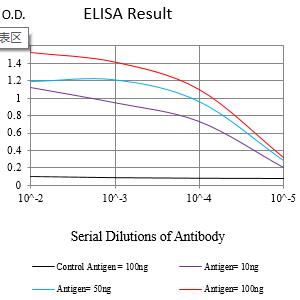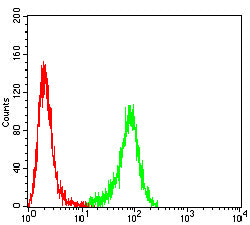

| WB | 咨询技术 | Human,Mouse,Rat |
| IF | 咨询技术 | Human,Mouse,Rat |
| IHC | 咨询技术 | Human,Mouse,Rat |
| ICC | 技术咨询 | Human,Mouse,Rat |
| FCM | 1/200 - 1/400 | Human,Mouse,Rat |
| Elisa | 1/10000 | Human,Mouse,Rat |
| Aliases | 2B4; NAIL; Nmrk; NKR2B4; SLAMF4 |
| Entrez GeneID | 51744 |
| clone | 4A6H8 |
| WB Predicted band size | 41.6kDa |
| Host/Isotype | Mouse IgG2b |
| Antibody Type | Primary antibody |
| Storage | Store at 4°C short term. Aliquot and store at -20°C long term. Avoid freeze/thaw cycles. |
| Species Reactivity | Human |
| Immunogen | Purified recombinant fragment of human CD244 (AA: 22-229) expressed in E. Coli. |
| Formulation | Purified antibody in PBS with 0.05% sodium azide |
+ +
以下是关于CD244抗体的3篇参考文献示例(文献信息为示例,需根据实际文献调整):
1. **文献名称**:*CD244 (2B4) Signaling in NK Cell Activation and Tolerance*
**作者**:Kumar V, McNerney ME
**摘要**:该综述探讨了CD244在自然杀伤细胞(NK细胞)中的双重作用,既能通过适配蛋白SAP介导激活信号,增强细胞毒性,也可在缺乏SAP时传递抑制性信号,调节免疫耐受。研究强调了CD244在病毒感染和肿瘤免疫中的潜在治疗价值。
2. **文献名称**:*2B4 (CD244) Is a Non-MHC Binding Receptor on Human NK Cells and Mediates NK Cell Inhibition of HIV Replication*
**作者**:Nakajima H, et al.
**摘要**:研究发现CD244抗体阻断可抑制NK细胞对HIV感染细胞的杀伤作用,表明CD244通过与HIV包膜蛋白相互作用调控NK细胞抗病毒功能,为HIV免疫逃逸机制提供了新视角。
3. **文献名称**:*CD244 Expression Marks Exhausted T Cells in Chronic Viral Infection*
**作者**:Blackburn SD, et al.
**摘要**:在慢性LCMV感染模型中,CD244高表达的CD8+ T细胞表现出功能耗竭特征(如IFN-γ分泌减少),提示CD244可能作为慢性感染中T细胞功能障碍的生物标志物,并与PD-1协同介导免疫抑制。
4. **文献名称**:*Co-expression of CD244 and PD-1 in Tumor-Infiltrating T Cells Defines a Subset of Dysfunctional Effector Cells*
**作者**:Bengsch B, et al.
**摘要**:在肿瘤微环境中,CD244与PD-1共表达的T细胞亚群表现出增殖能力下降和效应功能受损,靶向CD244可能增强PD-1抗体治疗的抗肿瘤效果。
---
**提示**:以上为模拟摘要,实际文献需通过PubMed/Google Scholar等平台检索确认。建议使用关键词“CD244 antibody”、“2B4 immune function”或结合具体研究领域(如“CD244 cancer”)筛选近年高引论文。
CD244. also known as 2B4 or SLAMF4. is a cell surface receptor belonging to the signaling lymphocyte activation molecule (SLAM) family. Expressed primarily on natural killer (NK) cells, CD8⁺ T cells, and subsets of CD4⁺ T cells, it plays a dual role in immune regulation by transmitting activating or inhibitory signals depending on cellular context and ligand engagement. Its structure includes two extracellular immunoglobulin-like domains that bind to CD48. a glycosylphosphatidylinositol (GPI)-anchored ligand expressed on antigen-presenting cells and infected or transformed cells. Intracellularly, CD244 interacts with adaptors like SAP (SLAM-associated protein) to modulate downstream pathways. Mutations in SAP-related pathways are linked to immune dysregulation, such as X-linked lymphoproliferative disease (XLP).
CD244 antibodies are critical tools for studying immune cell interactions, particularly in viral infections, cancer immunity, and autoimmune disorders. They are used to block or stimulate CD244 signaling, helping to dissect its role in NK cell cytotoxicity, T cell exhaustion, and immune synapse formation. Therapeutic applications are under exploration, with anti-CD244 antibodies being investigated for targeting dysfunctional immune cells in chronic infections or enhancing antitumor responses. Recent studies also highlight its potential as a biomarker for disease progression in conditions like chronic hepatitis or leukemia. Overall, CD244 antibodies bridge basic research and clinical translation in immunology.
×